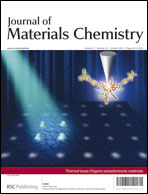Planar, bulk and hybrid merocyanine/C60 heterojunction devices: a case study on thin film morphology and photovoltaic performance†‡
Abstract
The growth of a thermally deposited merocyanine (HB364) thin film can be modified through insertion of a transition metal

- This article is part of the themed collection: Organic optoelectronic materials

 Please wait while we load your content...
Please wait while we load your content...